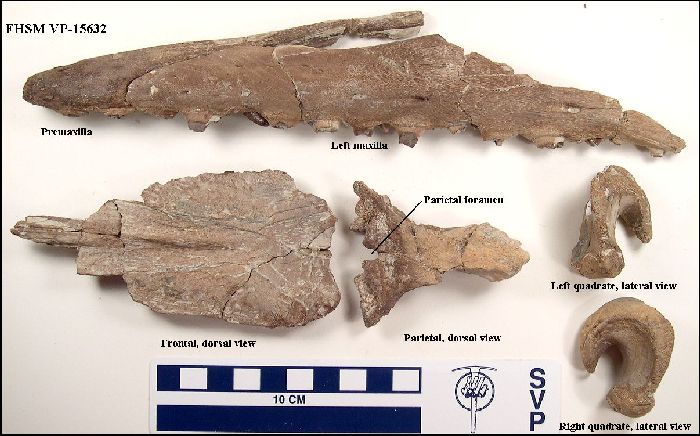
Tylosaurus novum sp. (kansasensis)
1990 discovery of a new species of mosasaur
from the Smoky Hill Chalk
Written and Illustrated by Mike Everhart; Copyright © 2000-2010
The story below describes the 1990 discovery of another specimen of the new species of Tylosaurus kansasensis (FHSM VP-15632).
***********
In June, 1990, we stopped by our favorite "Quinter South" site (named for a nearby town) in Gove County on the way back from a very windy day in the Pierre Shale with Pete Bussen. The day had not been productive and we were about ready to get on the road and start the boring three hour drive home. We drove into the site and parked in a big open area near the middle of the chalk badlands that we called "Central Park." I took a quick hike up one of the chalk canyons while Pam stayed near the van. The neat thing about this site is that you can find fossils everywhere. You just have to pick a direction and go for a walk.
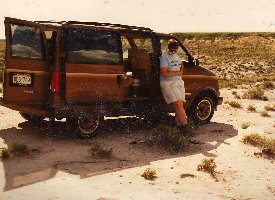 |
After about a half hour of not finding anything worth talking about, I headed back to the van. Pam met me as I walked up out of the gully and pointed to a scraggly sage bush sitting on a little mound of broken chalk about five feet from the right front tire of the van. "What's that?" she asked with a big grin on her face. I looked down and saw a small mosasaur vertebra and some other scraps of bone laying on the surface. They were partially hidden from view by the small bush whose roots were holding the little mound of chalk and bones together. |
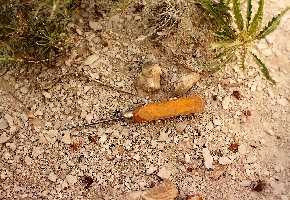 |
The tire tracks showed that I had almost driven the van right over the top the bush. Then Pam had nearly stepped on it when she got out of the passenger side door. Not only that, but we had walked right by it a dozen or more times in the last two years (I won't mention the names of some of our paleontologist friends who had also visited the site with us). It was hard to believe that we had not noticed the bones before. As I got down on my hands and knees and looked closely, more bones became visible. I could see identifiable parts of what appeared to be a small mosasaur skull. All of a sudden, I wasn't tired and hot anymore. |
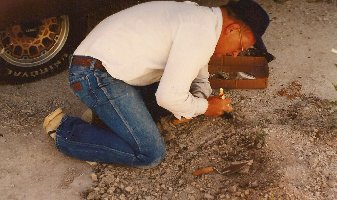 |
I got my tools out of the van and started brushing a way the loose pieces of chalk. From the way that the bones were laying, it was soon evident that that little bush had to go. As often happens, plants growing in this rocky soil tend to grow better when they can find some fossil bones to wrap their roots around. The fossil bones contain more minerals than the chalk, and somehow the plants find them. Given enough time, they will also seriously damage them. You can see one of the lower jaws just below my hand. |
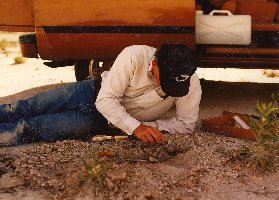 |
I carefully traced the major roots out that were near the surface and cut them away from the fossil bones. The skull appeared to be completely disarticulated but most of the pieces seemed to be there. |
 |
This photo shows a dorsal view of the frontal (left) and the broken parietal (right). Note the location of the parietal foramen. Scale is in centimeters. |
 |
This is another dorsal view of the frontal and the parietal, with the bones separated along the frontal/parietal suture. Again note the location of the parietal foramen, and that it is not totally enclosed by the parietal..... an unusual occurrence, but one of the defining characteristics of Tylosaurus kansasensis. |
 |
This photo shows the same two bones from below. These bones comprise the top of the skull in mosasaurs. The frontal (left) sits over the eyes, while the parietal is located over the brain. The parietal foramen is an opening in the skull for the pineal gland, a primitive 'third eye' in some amphibians and reptiles. Note that the opening is on the edge of the suture between the frontal and parietal, different from that of a typical Tylosaurus proriger or T. nepaeolicus. |
 |
This photo shows the left side of the premaxillary. The specimen was initially identified as a Tylosaurus on the basis of the pre-dental portion of the rostrum extending beyond the front teeth. |
 |
The premaxillary from above. The toothless (edentulous) portion is shorter and more rounded than a typical Tylosaurus proriger or T. nepaeolicus pre-max. |
 |
The anterior portion of the left maxillary. Almost all the teeth were weathered and broken. Tylosaur teeth do not preserve as well as the teeth of other species for some unknown reason. |
 |
The left and right quadrates (medial view). In mosasaurs, these bones provide the hinge point or joint for the lower jaws. They also support the ear drum. In Tylosaurus kansasensis, the quadrate is more rounded than that of a typical Tylosaurus proriger or T. nepaeolicus, and it does not have an infrastapedial process. |
 |
The left and right quadrates (lateral view). Because they are made up of very solid bone, they are among the most likely pieces of mosasaur skulls to be preserved as fossils. Fortunately, they also have a number of distinguishing features that allow them to be identified to the species level. |
 |
The left and right quadrates (anterior view). We went back to the site several times after the initial discovery and I crawled around looking for fragments that I might have missed earlier. |